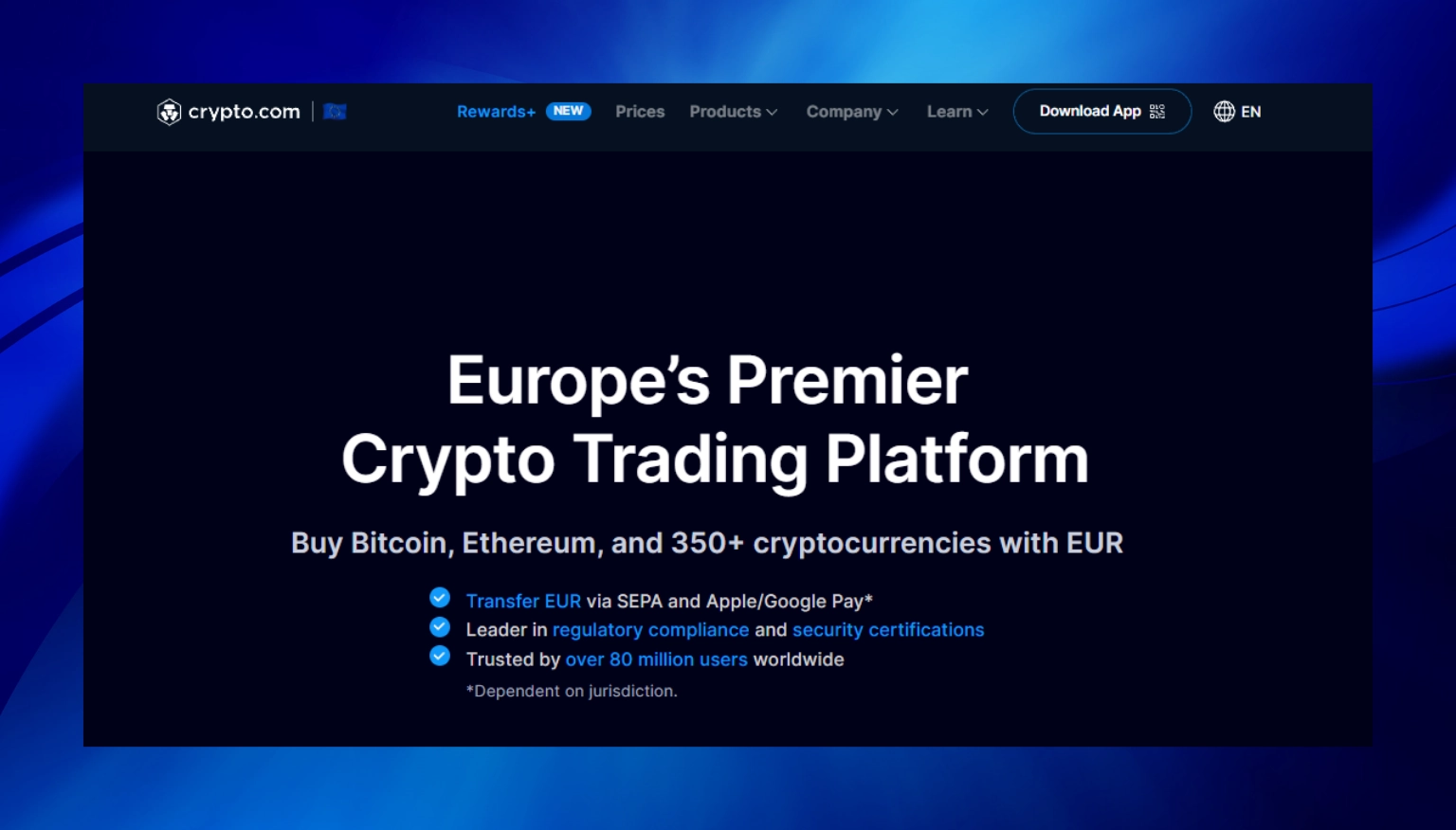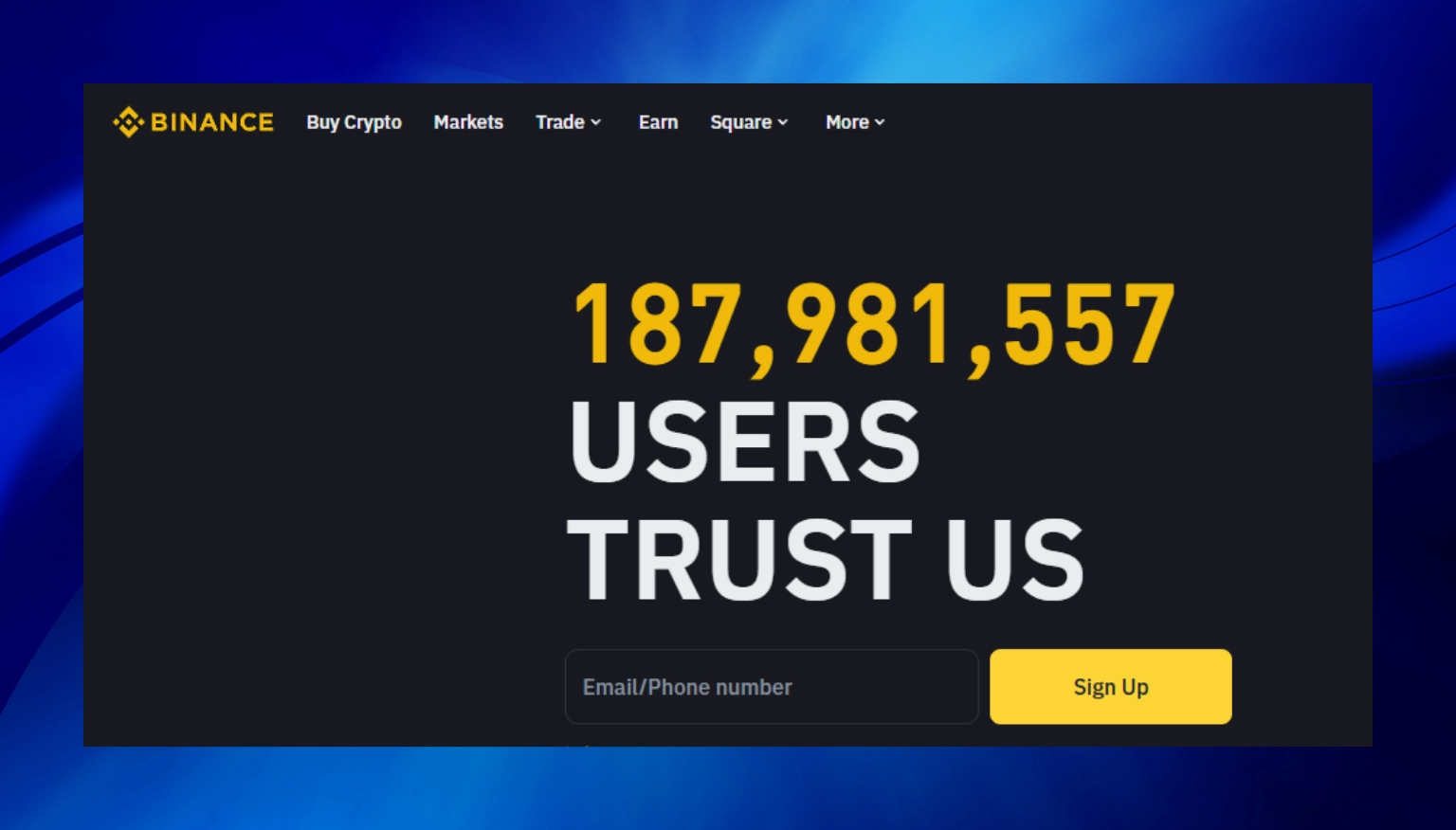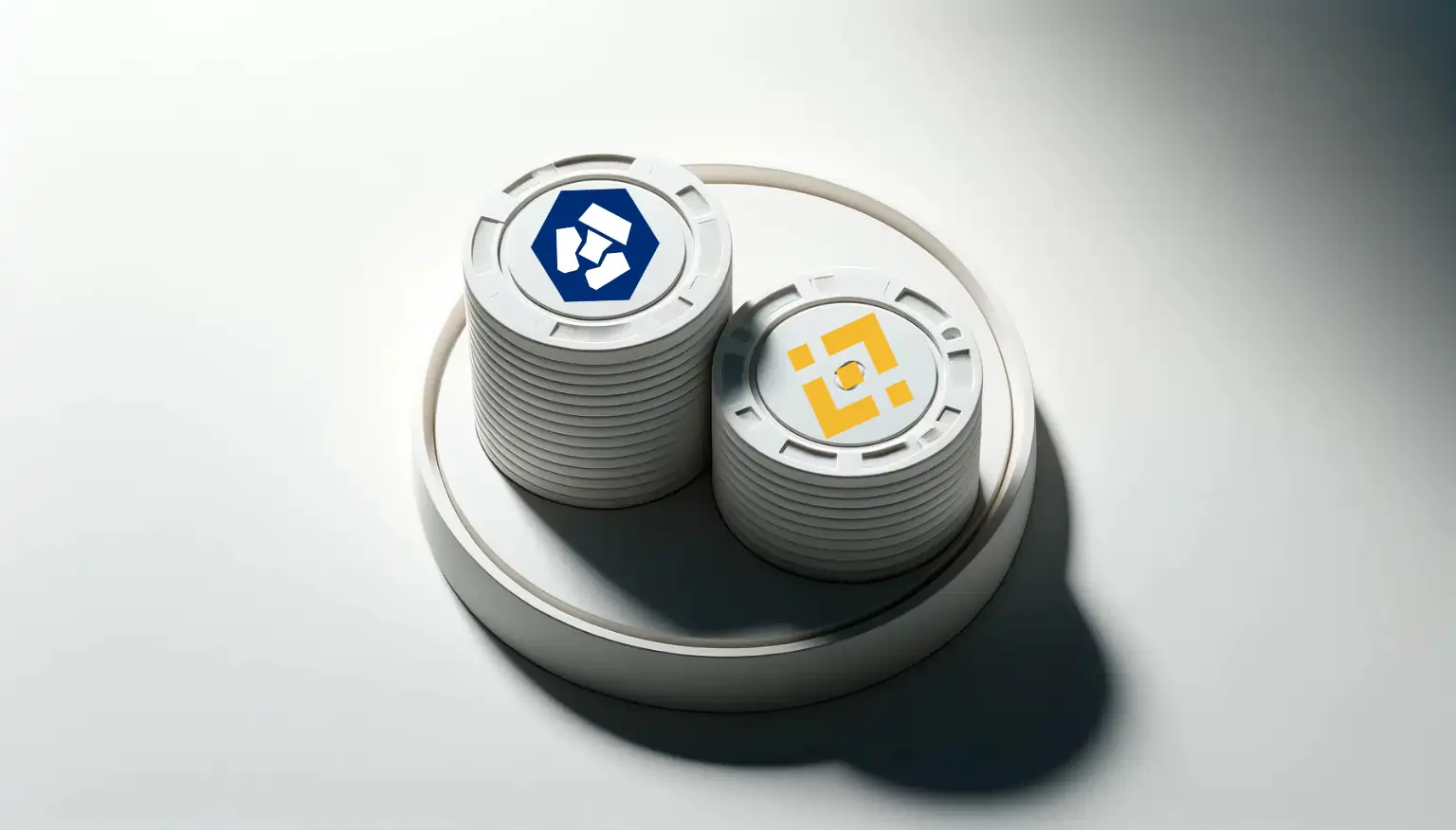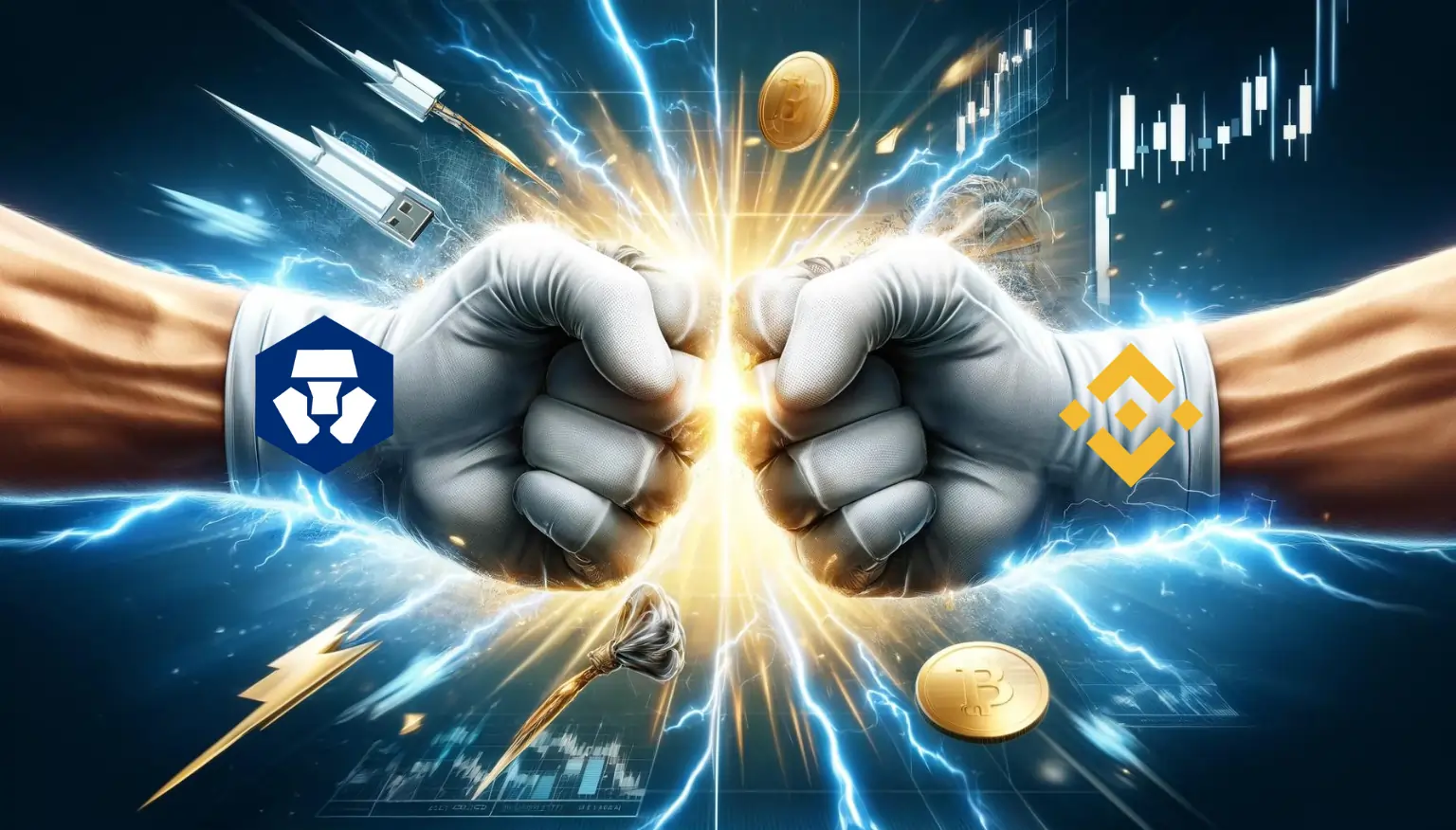Choosing the right cryptocurrency exchange can be as crucial as selecting your investments. Today, we’re diving deep into the rivalry that’s always hot on every crypto trader’s lips: Crypto.com vs Binance.
These platforms have been vying for the top spot, and it’s time we dissect each aspect to see which one might suit your trading needs best. To choose the right platform not only has to be aligned with your trading strategies but must also have the highest security standards and optimize its financial performance.
Whether you’re new to the crypto scene or a seasoned investor, understanding the nuances of these exchanges can greatly impact your trading strategy and results.
Let’s delve into the overview of each platform to gain a clearer picture of what Crypto.com and Binance have to offer.
Binance vs Crypto.com: Platform Overview and Key Features
Crypto.com Overview

In 2016, Bobby Bao, Gary Or, Kris Marszalek, and Rafael Melo established Crypto.com under the name “Monaco.” The company later rebranded in 2018 after purchasing the domain from Matt Blaze.
This crypto exchange has grown rapidly to establish itself as a major player in the cryptocurrency space. Its mission is simple: to accelerate the world’s transition to cryptocurrency.
The platform offers a wide array of services including a wallet app, MCO Visa Card, a robust exchange, and a range of crypto products like staking and crypto credit.
What sets Crypto.com apart is its aggressive pursuit of mainstream crypto adoption, evident from their high-profile marketing campaigns and partnerships with global sports brands.

Key features of Crypto.com include:
- Crypto.com Visa Card: One of the most appealing features is their Visa card that offers up to 8% back on spending in cryptocurrency.
- Crypto Earn and Credit: Users can stake their crypto and earn interest, or obtain a crypto credit line using their crypto holdings as collateral.
- Mobile App: Highly rated by users, the Crypto.com app simplifies buying, selling, trading, and tracking cryptocurrency.
Binance Overview

Launched in 2017 by Changpeng Zhao, Binance quickly ascended to the status of the world’s leading cryptocurrency exchange by trading volume.
Its swift rise is attributed to a broad range of trading options and a robust technological platform that caters to both beginners and experienced traders.
Binance is renowned for its extensive trading capabilities, including spot and derivatives trading. It supports a myriad of trading strategies with tools designed for traders at all levels.

Some of Binance’s key features are:
- Extensive Market Offerings: Binance offers an impressive range of cryptocurrencies and trading pairs, making it a favorite for traders looking for diversity.
- Advanced Trading Options: Includes features like futures and options trading, margin trading, and a peer-to-peer (P2P) exchange service.
- Binance Academy: An entirely free educational portal that provides training from beginner to advanced levels, helping users understand various aspects of cryptocurrencies and trading.
Both Crypto.com and Binance provide unique advantages that cater to different preferences and needs.
As we delve deeper into their offerings, fees, security measures, and customer experiences, we’ll provide you with the detailed insights needed to decide which platform aligns best with your crypto journey.
What is the Best Platform for Crypto Trading, Crypto.com vs Binance?
When comparing Crypto.com and Binance for trading capabilities, each platform offers distinctive advantages that cater to different types of cryptocurrency traders.
This section delves into the trading tools, charting features, order types, and overall trading experience to help you determine which platform could serve your trading strategies better.
Trading Tools and Features

Crypto.com provides a streamlined trading experience that is ideal for both beginners and experienced traders. The platform’s user interface is quite simple, making it easy to navigate and execute trades.
Features such as automated trading, price alerts, and real-time market updates enhance user engagement and trading efficiency.
Moreover, Crypto.com’s mobile app allows traders to manage their portfolios on-the-go, ensuring they never miss a market move.
Binance, known for catering to more experienced crypto investors, offers an extensive suite of trading tools that includes advanced charting options, technical analysis tools, and a customizable dashboard.
Binance supports a wide array of order types such as limit, market, stop-limit, and OCO (One Cancels the Other), providing traders with more flexibility to execute complex trading strategies.
Additionally, Binance’s trading platform is equipped to handle a high trading volume, making it a preferred choice for day traders and those who engage in high-frequency trading.
Supported Cryptocurrencies and Trading Pairs

Both exchanges offer a vast selection of cryptocurrencies, making them some of the most popular crypto exchanges globally.
Crypto.com supports over 150 cryptocurrencies and numerous trading pairs, including fiat-to-crypto transactions, which are ideal for traders looking to diversify their portfolios with both major and emerging crypto assets.
Binance excels with an even broader range of supported cryptocurrencies, boasting access to over 500 cryptocurrencies and hundreds of trading pairs.
This wide array makes Binance one of the best exchanges for accessing not only the most popular crypto assets but also lesser-known altcoins.
Binance vs Crypto.com: Which Platform Has the Best Trading Fees?

A major factor in choosing a cryptocurrency exchange is the cost associated with trading, primarily the trading fees.
Both Crypto.com and Binance offer competitive trading fee structures that can significantly affect your trading strategy and overall profitability.
Let’s compare their trading fees to determine which platform might be more cost-effective for your trading activities.
Fee Comparison
Both Crypto.com and Binance utilize an exchange’s tiered fee structure, which is prevalent among major cryptocurrency exchanges.
This structure is specifically designed to incentivize higher trading volumes with lower trading fees.
At Crypto.com, the fees are categorized into maker and taker fees, which vary based on your trading volume over a 30-day period.
The higher your trading activity, the lower your fees. Additionally, traders can further reduce their fees by using Crypto.com’s native cryptocurrency, CRO, to cover trading fees, thus enjoying significantly discounted trades.

Binance, recognized for offering one of the lowest trading fees in the market, similarly benefits users through its tiered fee system.
This system is structured to advantage both low-volume retail users, who generally face higher fees at major competitors, and high-volume institutional traders, who can achieve exceptionally low fee rates.
Like Crypto.com, Binance provides further fee reductions for users who hold and use BNB, the exchange’s native cryptocurrency, for fee payments.
This strategy not only enhances user savings but also bolsters the utility and circulation of BNB within the trading platform.
While both platforms strive to keep trading costs competitive, Binance is often perceived as having an edge in this area, especially for users engaged in significant trading volumes who can benefit from substantially lower fees compared to other exchanges that charge higher fees.
Types of Fees
- Maker-Taker Fees: Both platforms adjust maker and taker fees based on the trading volume. Generally, Binance offers slightly lower fees compared to Crypto.com, especially at higher trading volumes.
- Withdrawal Fees: Crypto.com and Binance both charge withdrawal fees, which are network fees for withdrawals. However, these fees can vary widely depending on the specific cryptocurrency you want to withdraw. It’s essential to check the latest fees directly on their platforms as these can fluctuate based on network congestion and other factors.
Special Fee Discounts and Programs
Crypto.com offers CRO cashback rewards and also a staking program where users can stake CRO to lower their trading fees further. Engaging in this program can be particularly advantageous for frequent traders looking to maximize their earnings.
Binance provides additional discounts through its VIP tiers, where traders can achieve even lower fees based on their trading volume and BNB balance. This can be a key factor for high-frequency traders who operate with large volumes.
How Do You Pay Trading Fees on Each Platform?

Understanding the mechanisms for paying trading fees is essential for most traders who use platforms like Crypto.com and Binance, as it directly impacts the cost-effectiveness of transactions.
Each platform has distinct methods and incentives for paying trading fees that can benefit users differently depending on their trading habits and preferences.
Payment Methods for Trading Fees
Crypto.com offers several convenient options to pay trading fees. Users can choose to pay fees directly with the cryptocurrency they are trading or utilize Crypto.com’s native cryptocurrency, CRO, to pay trading fees.
Using CRO to pay trading fees on Crypto.com not only simplifies the process but also provides additional discounts, making it a cost-effective option for traders.
This incentive is designed to encourage the usage of CRO within its ecosystem, benefiting users with some of the lowest fees.

Binance, on the other hand, encourages its users to use BNB, Binance’s native cryptocurrency, to pay for trading fees. By choosing BNB to pay trading fees, users enjoy a significant reduction in the cost per trade.
This discount is part of Binance’s strategy to integrate its native token into the trading experience and enhance its utility.
Additionally, Binance users can also pay trading fees using the cryptocurrency they are trading, but using BNB provides the added benefit of reduced fees.
Benefits of Using Native Cryptocurrencies for Fee Payment
- Lower Fees: Both platforms offer a reduction in trading fees for users who opt to use their native cryptocurrencies (CRO on Crypto.com and BNB on Binance). This is a key factor for many traders in optimizing their trading strategies and maximizing profitability.
- Simplified Payments: Using a native cryptocurrency streamlines the trading process by eliminating the need to convert between different cryptocurrencies to cover fees. This can also reduce transaction times and potential cost due to slippage.
Additional Considerations
- Availability: While both platforms support credit or debit card payments for buying crypto, when it comes to paying trading fees, the use of native tokens is highly promoted and incentivized.
- Market Conditions: It’s important to consider the market conditions of native cryptocurrencies like CRO and BNB. Since their values can fluctuate, this could affect the overall cost effectiveness of using them to pay fees.
Do Both Allow Margin Trading and Futures Trading?
Margin trading and futures trading are advanced trading options that appeal particularly to more experienced crypto investors.
These options can significantly enhance trading capabilities and potential profits but also come with increased risks.
Let’s explore whether Crypto.com and Binance offer these trading options and what they entail for users.
Margin Trading

Crypto.com provides margin trading as a feature that allows traders to borrow money against their existing coins to trade cryptocurrency pairs on leverage.
This feature is designed to amplify trading results, enabling traders to potentially increase their profits from successful trades.
However, it’s crucial to note that while it increases potential profits, it also increases potential losses, making it suitable for more experienced cryptocurrency traders.
Binance offers margin trading with a wide range of cryptocurrencies, providing traders with the flexibility to choose their preferred trading pairs.
Binance’s exchange allows higher levels of leverage compared to many other popular exchanges, which can be particularly attractive to traders who have a high tolerance for risk and a strong understanding of market mechanisms.
Futures Trading

Another advanced feature that both platforms offer is futures trading. Futures contracts are agreements to buy or sell cryptocurrency at a predetermined price at a specified time in the future.
These are popular among traders who wish to speculate on the future price of crypto assets.
Crypto.com supports futures trading with competitive features like low trading fees, high-leverage options, and a user-friendly interface that enhances trading experience and management.
Their exchange provides a structured approach to futures trading, which can be advantageous for those new to futures.
Binance, known as one of the most popular crypto exchanges for futures trading, offers an even more robust trading environment with features that support a high trading volume.
Binance provides a variety of futures contracts, including perpetual and quarterly contracts, across a wide array of cryptocurrencies.
Binance’s futures trading platform is equipped with comprehensive tools to help traders manage risk, such as detailed charting tools and various order types.
Security and Trust: How Do Crypto.com and Binance Protect Your Investments?
In the world of cryptocurrency trading, security is paramount. Traders need to trust that their funds and personal information are safeguarded against unauthorized access and potential cyber threats.
Let’s evaluate how Crypto.com and Binance handle security measures and the trust they have built among their users.
Security Features

Crypto.com places a strong emphasis on security with a multi-layered approach that includes cold storage of assets, a dedicated security team, and the use of HSMs and multi-signature technologies.
Additionally, Crypto.com is one of the first cryptocurrency exchanges to have ISO/IEC 27001:2013 and PCI:DSS 3.2.1, Level 1 compliance, demonstrating a commitment to maintaining high-security standards.
They also offer a feature called ‘Crypto.com Secure Asset Fund for Users (SAFU)’, which acts as a reserve fund to cover potential losses from extreme situations.
Binance also prioritizes security, employing an industry-leading security system that includes the SAFU (Secure Asset Fund for Users), cold storage of the majority of funds, and systems designed to detect and block phishing attempts and other malicious activities.
Binance’s approach to security is proactive, with regular updates to their security measures and protocols to stay ahead of potential cyber threats.
User Trust and Reliability

Both exchanges have generally maintained a strong trust among their users, although both have faced challenges.
Crypto.com has successfully managed to keep user funds secure with no major security breaches reported, enhancing their reputation within the crypto community.
Binance, while it has experienced a significant security breach in the past, has taken substantial steps to address these issues, including reimbursing affected users through their SAFU fund, which has helped to rebuild and maintain trust.
Binance’s transparent communication during and after incidents has been crucial in maintaining user confidence.
Regulatory Compliance

Regulatory compliance is a key aspect of security and trust. Crypto.com has aggressively pursued compliance with regulatory requirements in multiple jurisdictions.
Obtaining significant certifications and licenses reassures users of its commitment to legal and security standards, including anti-money laundering measures and safeguards against unauthorized withdrawals.
This robust approach enhances trust, especially for users who rely on bank transfers for funding their accounts.
On the other hand, Binance has faced more scrutiny and encountered several regulatory issues across different countries.
However, it continues to work towards compliance, engaging with regulatory bodies to ensure it meets the necessary standards wherever it operates.
By addressing these challenges, Binance strives to secure user trust and maintain operational stability in the long term.
This commitment to regulatory compliance is important for ensuring long-term stability and building user trust, especially in an environment where financial security is paramount.
Choosing Between Binance vs Crypto.com – Which One Is the Best Exchange for You?

After comparing Crypto.com vs Binance, deciding between these cryptocurrency exchanges depends heavily on your specific trading needs, experience level, and priorities in features and security.
Both platforms offer robust services that cater to a diverse range of traders—from beginners seeking ease of use and straightforward options to more experienced traders looking for advanced trading capabilities and comprehensive market tools.
Crypto.com stands out for its user-friendly interface, strong emphasis on security with comprehensive insurance policies, and the added benefits of its native cryptocurrency, CRO, which offers reduced trading fees and other perks.
It’s an excellent choice for those who value a straightforward, secure trading experience and a variety of crypto-related services including a crypto Visa debit card, earning interest on crypto assets, and mobile app functionality.

Binance, on the other hand, is more suited for traders who prioritize a wide range of trading options, including extensive market pairs, low trading fees, and advanced trading tools.
With its larger ecosystem, Binance provides more flexibility for engaging in various trading strategies and access to higher liquidity.
It remains a favorite among traders for its competitive fee structure and a strong educational push through Binance Academy.
Ultimately, both Crypto.com and Binance are leaders in the cryptocurrency exchange space, and choosing between them should be based on aligning their offerings with your trading goals.
Whether you value a seamless user experience with solid security and excellent customer service or a more comprehensive exchange with low fees and high trading volume, both exchanges offer compelling reasons to be chosen as your go-to platform in the dynamic world of cryptocurrency trading.
With this comparison, we hope you have a clearer understanding of what each crypto exchange can offer and can make a more informed decision that best fits your trading style and needs. Happy trading!
Interested in learning more? Don’t miss our best educational articles:
- What is Web3?
- What is Decentralized Physical Infrastructure?
- What are Testnets? Delving into Key Blockchain Dev Environments
- Permissioned vs Permissionless Blockchain: What Are They?
- What Is the Best Crypto Accounting Software?
Discover them all by visiting our Learn section!

